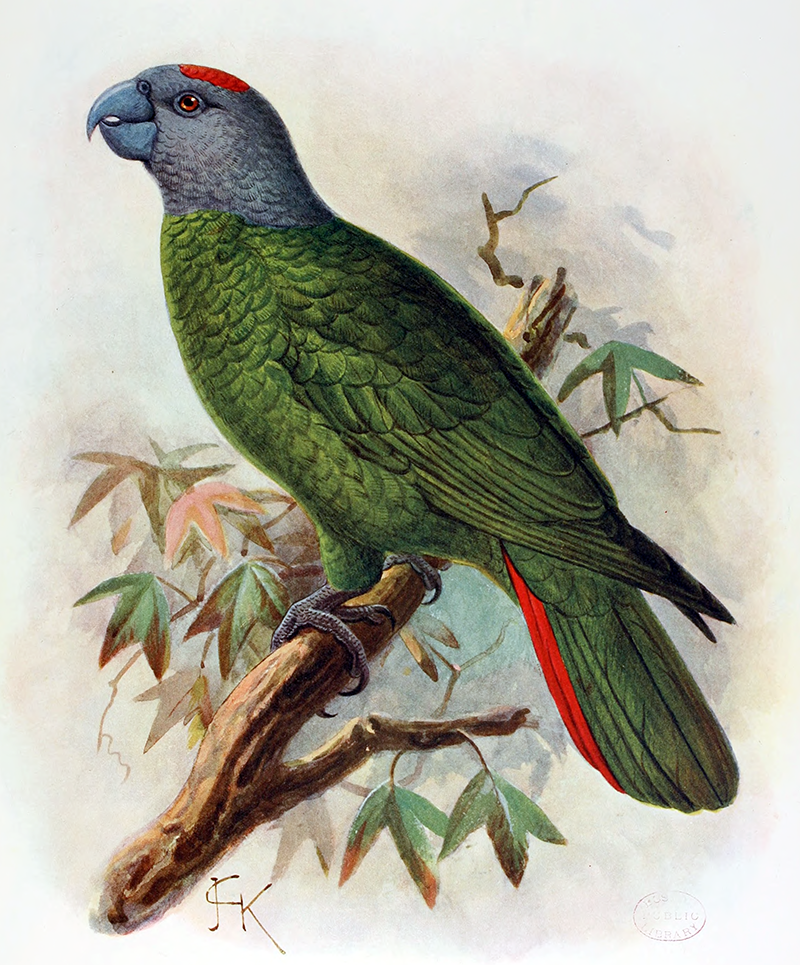Amazona martinicana Clark, 1905
Martinique amazon, Martinique parrot
Taxonomy & Nomenclature
Synonym/s: Amazona martinica Clark, 1905 (used by Day, 1981:78)
This is a hypothetical species based upon the accounts of Labat (1742) and Buffon (1779) (Day, 1981:78; BirdLife International 2012). Labat described the Guadeloupe and Martinique forms of Amazon as virtually the same, indicating either that he was confused as (Day, 1981:78) suggests, or that its distribution covered both islands, perhaps with each island harbouring an endemic subspecies, which would account nicely for the minor differences in description given by Labat of the two putatively different forms.
Conservation Status
Hypothetical species
Last record: 1779 (BirdLife International, 2021; Kittelberger et al., 2024); 1800 (BirdLife International, 2016)
IUCN RedList status: Extinct
Distribution
Martinique
Biology & Ecology
Hypodigm
Media

Above: illustration based upon written accounts, by John Gerrard Keulemans. Published in (Rothschild, 1907). Source: Wikimedia Commons.
References
Original scientific description:
Clark, A. H. (1905). The West Indian parrots. The Auk 22: 337-344.
Other references:
Bird, J. P., Martin, R., Akçakaya, H. R., Gilroy, J., Burfield, I. J., Garnett, S. G., Symes, A., Taylor, J., Şekercioğlu, Ç. H. and Butchart, Stuart H. M. (2020). Generation lengths of the world’s birds and their implications for extinction risk. Conservation Biology 34(5): 1252-1261.
BirdLife International. (2012). Amazona martinicana. In: IUCN 2013. IUCN Red List of Threatened Species. Version 2013.1. (http://www.iucnredlist.org). Downloaded on 19 August 2013.
BirdLife International. (2016). Amazona martinicana. The IUCN Red List of Threatened Species 2016: e.T22728705A94994181. https://dx.doi.org/10.2305/IUCN.UK.2016-3.RLTS.T22728705A94994181.en. Downloaded on 27 June 2021.
BirdLife International. (2021). Amazona martinicana. The IUCN Red List of Threatened Species 2021: e.T22728705A194903850. https://dx.doi.org/10.2305/IUCN.UK.2021-3.RLTS.T22728705A194903850.en. Accessed on 12 June 2022.
Brooks, T. (2000). Extinct species, pp. 701-708. In: BirdLife International (ed.), Threatened Birds of the World. Barcelona and Cambridge, U.K.: Lynx Edicions and BirdLife International.
Day, David. (1981). The Doomsday Book of Animals: A Natural History of Vanished Species. New York, N.Y.: The Viking Press.
del Hoyo, J., Collar, Nigel J., Christie, D. A., Elliott, A. and Fishpool, L. D. C. (2014). HBW and BirdLife International Illustrated Checklist of the Birds of the World. Volume 1: Non-passerines. Lynx Edicions BirdLife International, Barcelona, Spain and Cambridge, UK.
del Hoyo, J., et al. (2020) Birds of the World. Cornell Lab of Ornithology, Ithaca, NY, USA
Greenway James C. (1967). Extinct and Vanishing Birds of the World. American Committee for International Wild Life Protection, Special Publication no 13, 2nd edn. Dover Publications, New York.
Kittelberger, Kyle D., Tanner, Colby J., Buxton, Amy N., Prewett, Amira and Şekercioğlu, Çağan Hakkı. (2024). Correlates of avian extinction timing around the world since 1500 CE. Avian Research 15: 100213. https://doi.org/10.1016/j.avrs.2024.100213 [Supplementary data (List of 216 taxa)]
Rothschild, Lionel Walter. (1907). Extinct birds: an attempt to write in one volume a short account of those birds which have become extinct in historical times, that is within the last six or seven hundred years: to which are added a few which still exist, but are on the verge of extinction. London: Hutchinson & Co. XXIX + 243 pp. [p. 57, pl. 18]
Sayol, Ferran, Steinbauer, Manuel J., Blackburn, Tim M., Antonelli, Alexandre and Faurby, Søren. (2020). Anthropogenic extinctions conceal widespread evolution of flightlessness in birds. Science Advances 6(49): eabb6095. https://doi.org/10.1126/sciadv.abb6095 [Supplementary Material (Data File S1)]
Tyrberg, Tommy. (2009). Holocene avian extinctions, pp. 63-106. In: Turvey, Samuel T. (ed.). Holocene Extinctions. Oxford, UK & New York, USA: Oxford University Press. xii + 352 pp.
Williams, Mathew I. and Steadman, David W. (2001). The historic and prehistoric distribution of parrots (Psittacidae) in the West Indies, pp. 175-189. In: Woods, Charles A. and Sergile, Florence E. (eds.). Biogeography of the West Indies: Patterns and Perspectives, 2nd ed. Boca Raton, Florida: CRC Press.
<< Back to the Psittaciformes (Cockatoos and Parrots) database
